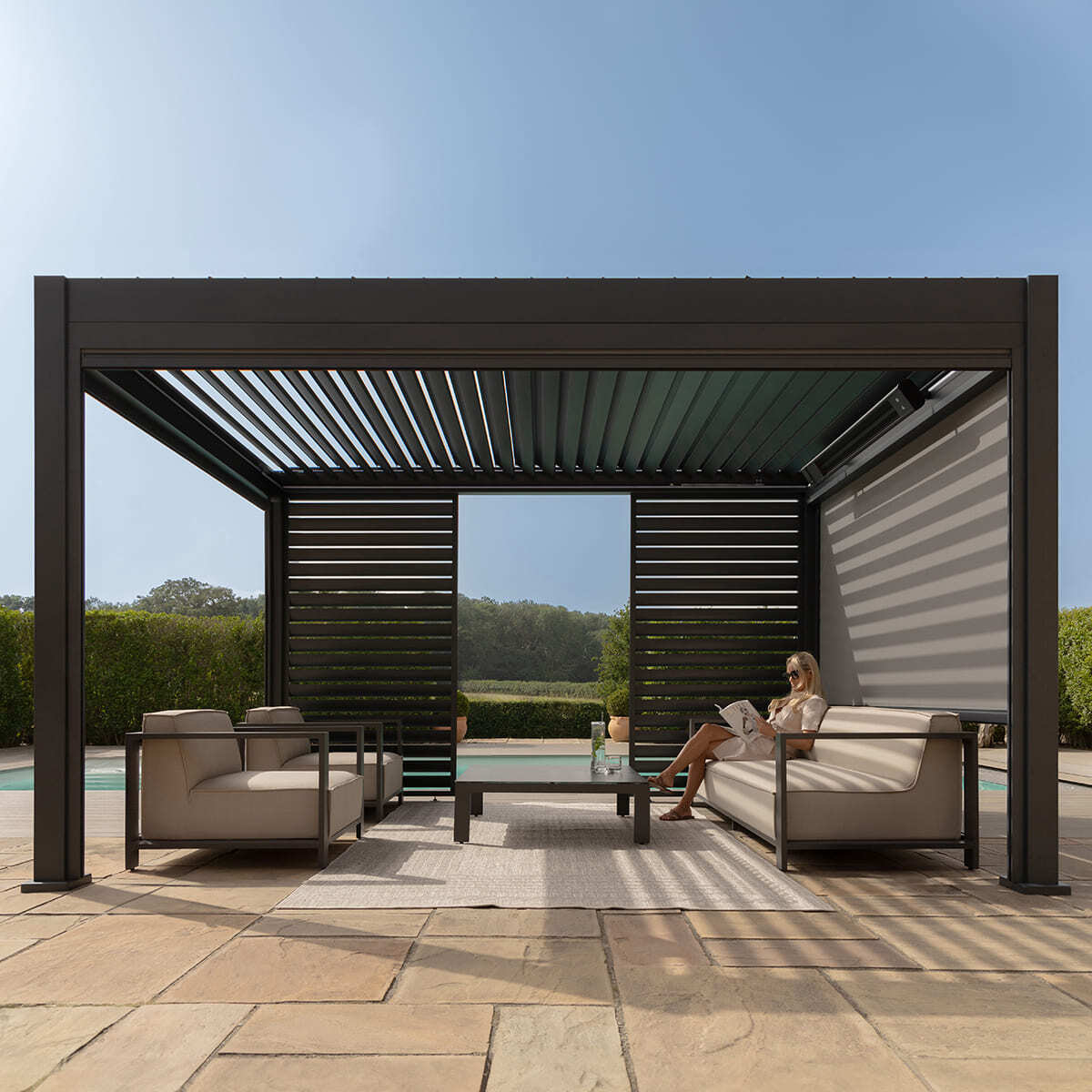
What is the purpose of a pergola?
I thought it might be useful to talk about the general pros and cons to purchasing a pergola...I have learnt through my job and speaking to people every day that some aren't even sure why a pergola may be useful.
I get questions like: 'Do they even keep you dry during showers?' 'Surely there is no shade under a pergola?' 'Is there really any point to having one' all of these common misconceptions made me think that it is time to offer a breakdown of what they actually are and what offerings they may bring to your outdoor space..

Image: The Rota Louvered Pergola can provide an outdoor sofa and firepit area onto decking.
So How do Pergolas Work?
At its core, a pergola can be defined as an open-sided structure consisting of posts or columns that uphold an open roof structure composed of rafters and beams. While various types of pergolas exist, they are generally characterized as open-air structures. The main function of pergolas is to delineate outdoor areas, enhance visual appeal, and, depending on the design, provide shade. Pergolas are commonly constructed from materials such as wood, vinyl, metal, fiberglass, or a blend of these options.
Pergolas bring versatility
One of the appealing aspects of a pergola is its versatility in terms of placement, as it can either be attached to a structure or stand independently. Whether installed on a deck, patio, garden area, near a pool, or above an outdoor dining space at a restaurant, a pergola offers flexibility in location. Due to its basic construction of posts, beams, and rafters, a pergola is well-suited for DIY projects.
Or alternatively, there are always installation options, so you can enjoy your new outlook to your garden even sooner.
With a relatively straightforward assembly process and fewer materials required compared to other outdoor structures, pergolas can still make a significant visual impact on a backyard or outdoor area.


Image; Aluminium Louvered Pergola-attached to back of house, creating an additional outdoor kitchen/dining area.
Disadvantages of a Pergola
Now, let's explore the drawbacks associated with having a pergola. One common concern raised is the lack of shade provided by pergolas. This statement can be both true and false, depending on the type of pergola in question. Traditional pergolas typically feature open rafters or a lattice-style roof, which may not offer substantial shade.
The level of shade provided depends on the spacing between the rafters or lattice elements, with closer proximity resulting in increased shade. However, it is important to note that such pergolas are often designed more for decorative purposes rather than solely for shade provision.
The more modern aluminium pergolas also offer the option of drop sides, screen or louvre panels which solve the problem when needing shade and create an extra layer of privacy. The below Como Pergola by Maze offers a louver roof option which includes LED lighting and 4 privacy screens in the price.


Image: Example of the Maze Como Manual Louvered Pergola Including 4 Drop Sides and LED Lighting.
Pergolas with retractable roofs such as the Rota Louvered are the best option if its not just decoration you are after, these do serve the purpose of offering shade with their louvered roof shutters which create a fully weatherproof space come rain or shine by a turn of the handle.


Image: The Rota Louvered Roof with Easy Pulley mechanism
Or if you are looking for even more sophistication in your pergola then Maze now offer a motorised, remote controlled, retractable roof option, in The Eden. See below:

The Eden Motorised Louvered Roof Pergola
Another potential drawback of a pergola to consider is the maintenance required for its upkeep and longevity. Wooden pergolas, in particular, necessitate annual maintenance to prevent issues like rotting, warping, sagging, and fading. While cedar or redwood pergolas offer better resistance to weather and insects compared to pine, regular sanding and staining every few years are still necessary. Additionally, replacing any deteriorating boards or loose hardware is essential to prolong the lifespan of a wood pergola.
Alternatively, materials such as aluminum or vinyl provide durable options that surpass the longevity of wooden structures.
 Image: Maranza Deluxe Aluminium Pergola; strong and robust
Image: Maranza Deluxe Aluminium Pergola; strong and robust
So what is the purpose of a pergola?
For many, its primary function is aesthetic enhancement. A pergola has the ability to elevate the visual appeal of a simple back garden, establishing a deliberate space that serves as a captivating focal point and introduces architectural intrigue to an otherwise flat outdoor area.
Pergolas are commonly utilised to designate specific zones for particular activities. For instance, a pergola may be employed to define an outdoor room for activities like dining or cooking or even a hot tub area.



It can create an inviting environment for social gatherings, day or night, or provide a cosy spot for relaxation with a good book. As pergolas come in various designs and sizes, the benefits they offer can vary based on the specific type chosen for your home. Whether seeking shade, shelter, or comfort, a pergola can cater to these needs when selected with consideration for your preferences and requirements.
So what are the main benefits of a pergola?
- Easy to assemble
- Less expensive than other types of structures
- Aesthetically pergolas provide beauty, create a focal point, and visual interest to highlight an outdoor gathering space
- Versatile & Light weight and can be used on decking as well as on patios, over landscape pavers, and garden areas.
- Semi-permanent structure: Can be attached to an existing wall or structure or used as a fully free standing design
- Easy to fit into your home’s décor – either by the style of pergola chosen or material
- The open air structure with or without louvered roofs, make pergolas safe to use with firepits or gas fire tables as well as outdoor kitchens, grills and smokers
- Easy to decorate and add character and charm with accessories such as LED or festoon lights, fans, curtains, plants and climbing vines.
- The right pergola can add shade to your space by use of drop screens, zip blinds, panelled louvres and or manual or electric retractable roof tops.
Hopefully now, when someone criticises the idea of pergolas, you can confidently counter with a list of reasons highlighting their benefits. While pergolas may not suit every space or homeowner, they undeniably offer unique advantages and are appreciated by individuals worldwide.




